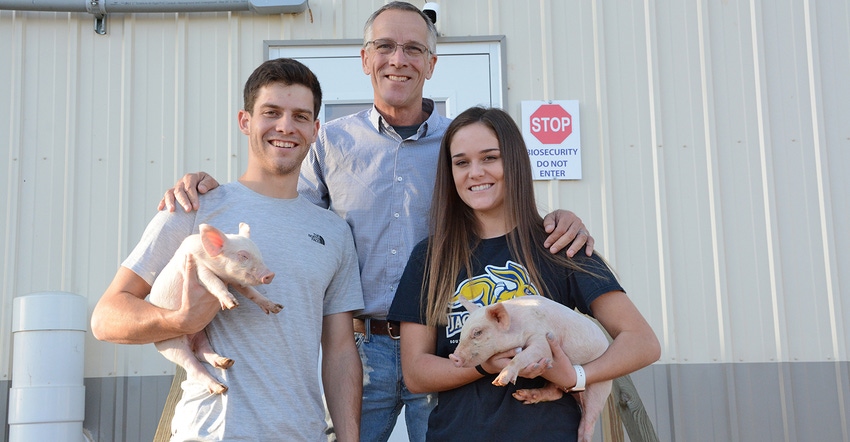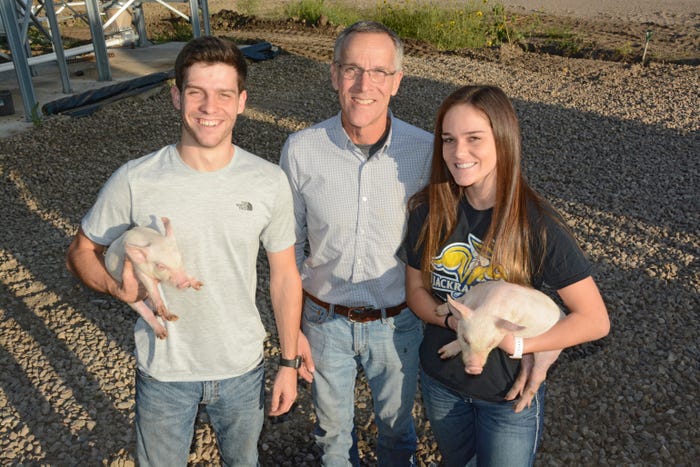
“It’s the best thing we have ever done,” says Karl Schenk, Mission Hill, S.D., of the three hog barns he and his wife, Nancy, and their children put up a year ago. One is a 2,400-head nursery; the other two are 2,400-head finishers. They contract grow and finish pigs for Sunterra Farms, which has about 80 barns in the state.
“The return on the investment is averaging 11%,” Schenk says. “What else in agriculture generates 11%?
Plus, the Schenks own the manure generated by the pigs. They are fertilizing 400 acres corn with hog manure. They don’t have to purchase any commercial fertilizer for those acres.
“It is a significant savings, and it is good for the soil,” he says.
Kids coming home
The profit from the barns is making it possible for the Schenks’ son to farm with them, and for their daughter to have the opportunity to join them.
Karl II, 21, is a junior at the University of Nebraska. He took out a beginning farmer loan to help finance construction of the nursery.
Kyra, 17, is a high school senior. She wants to be a large animal vet, something she became interested in when she started helping with the pigs in the nursery. When she is 18, she will be able to apply for a beginning farmer loan to put up a hog barn of her own.
 FAMILY OPERATION: Karl Schenk (center), and his children, Karl II and Kyra, operate a contract nursery and two finishing barns together.
FAMILY OPERATION: Karl Schenk (center), and his children, Karl II and Kyra, operate a contract nursery and two finishing barns together.

“I don’t think there is a better way for young people to start building equity,” Schenk says.
Second wave
A lot of expansion in contract finishing pigs has already occurred in South Dakota, but there could be a second wave of development. The swine industry projects there will be demand for 400,000 more hog spaces in the Western Cornbelt in the next two to three years, according to Nathan Jensen, senior vice president, First Dakota National Bank, Beresford, S.D.
Half of those spaces — or approximately 85 new 2,400-head finishing barns, plus 28 nursery barns — could be built in South Dakota, he says.
Swine integrators are interested in placing more animals in South Dakota for two main reasons:
1. Isolation. Retailers are paying a premium for pork raised without antibiotics. Lots of distance is needed between hog barns to keep pigs healthy so antibiotics aren’t needed. “It’s value-added all through the supply chain,” Jensen says.
2. Cheaper feed. Corn typically costs $.40-$.60 cents less per bushel in South Dakota than in the major hog producing states due to the state’s wider commodity basis. The basis is the difference between local cash and Chicago Board of Trade prices. It reflects local demand for commodities. South Dakota soybeans are usually $.80 to $1 per bushel cheaper. Corn and soybeans are the primary ingredients in swine rations. “The basis advantage gives integrators a source of cheaper feed and ultimately increased margins,” Jensen says.
Permit hurdle
One of the biggest hurdles to getting into the contract pig business is obtaining conditional use and building permits for new barns.
In South Dakota, county and township officials control zoning and building permits. How counties treat hog barns varies widely. Some counties welcome the barns and the increase in economic activity that the barns generate. South Dakota State University economists calculate that every finishing pig generates $203 in economic activity in a community, says Robert Thaler, SDSU Extension swine specialist.
“A 2,400-head finishing barn would equate to an impact of $487,200 to a rural/local community,” he says.
But not all counties have regulations that encourage livestock development. Instead, they have setbacks and other zoning requirements that are difficult, if not impossible or impractical, to meet in some cases. Also, there are vocal critics of Concentrated Animal Feeding Operations (CAFOs), and especially hog barns in some counties. They can have a great deal of influence on county politics.
Surprisingly, some of the most ag friendly counties in South Dakota are the most densely populated — Minnehaha and Lincoln counties (Sioux Falls), Brookings County (Brookings), and Kingsbury County (Watertown), says Steve Dick, executive director of Agriculture United for South Dakota, a trade association that supports family farms and ranches.
“They are professional and fair,” he says.
Yankton County, where Schenk farms, is now thought to be one of the toughest places to put up hog barns.
There are many residents in Yankton County who oppose CAFOs, according to Dan Klimisch, chairman of the Yankton County board of commissioners.
They are concerned about odor emissions, water pollution, road degradation and the inability to attract new businesses if the county is perceived to be environmentally unhealthy or aesthetically unattractive, he says.
Klimisch says he doubts the economic benefits generated by CAFOs will offset the increased cost of road maintenance and losses to the county’s tourism industry. Lewis and Clark Lake, a popular vacation destination on the Missouri River, is located in Yankton County
 ANTIBIOTIC FREE: Karl II Schenk and his sister, Kyra, hold two of the healthy, antibiotic-free pigs that they are raising in his nursery barn.
ANTIBIOTIC FREE: Karl II Schenk and his sister, Kyra, hold two of the healthy, antibiotic-free pigs that they are raising in his nursery barn.

“The majority of Yankton County residents don’t agree with the concerns of the livestock producers who have approached the commission,” Klimisch says. “We can’t make everyone happy. Our goal is to make the majority happy.”
Going to court
A citizens group sued Schenk, other farmers and the county when the county approved their barns in 2018. Those and other cases were dismissed, but Schenk had to spend an extra $40,000 on attorney fees to build the barns.
“It was a fight I was willing to have, and an investment I was willing to make,” Schenk says.
If farmers can meet all the environmental regulations, they should be able to raise pigs in an area that is zoned for agricultural use, he says.
That premise will likely to tested in many counties in the future.
Loretta Sorensen, a writer from Yankton, S.D., contributed to this article.
Read more about:
CafoAbout the Author(s)
You May Also Like






